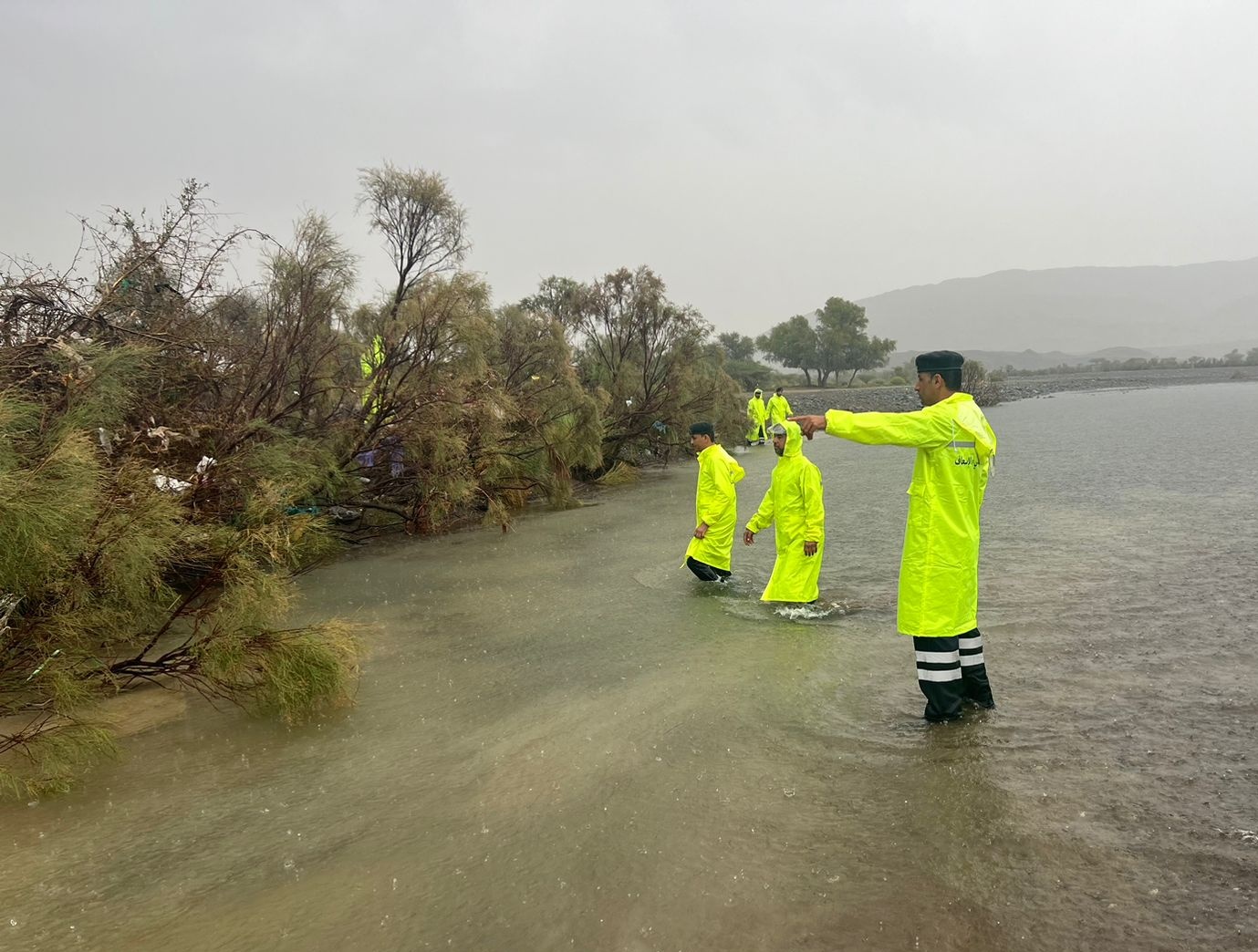What we’re watching: Weekly disaster update, April 22

We know all too well that disaster can strike anytime, anywhere in the world. Some disasters make headlines; others do not. Here at the Center for Disaster Philanthropy (CDP), we monitor the status of disasters worldwide and compile a list of the ones we’re tracking weekly, along with relevant disaster-related media coverage.
Here’s what we’re watching for the week of April 22, 2024.
New or Emerging Disasters
Flooding – Oman and the United Arab Emirates: A deadly storm lashed Oman on April 14 and triggered flash floods in parts of the country. At least 19 deaths were reported, and the government suspended all work, school and public transportation in the most affected governorates. Severe flooding was also reported in the United Arab Emirates (UAE), including Dubai, which received over a year’s worth of rainfall in 24 hours, the heaviest rainfall since records began in 1949. At least four deaths were confirmed; three were migrant workers from the Philippines.
Migrant workers are an essential part of the countries’ labor force and were found to be exposed to escalating climate risks due to poor living conditions and lack of legislation and rights such as employer-provided mandatory health insurance.
Complex Humanitarian Emergency – Myanmar: New fighting between the Myanmar military and the Karen National Union (KNU), an ethnic armed group near the Thailand border, forced around 3,027 civilians to flee to Thailand. On April 19, explosions and heavy machine-gun fire were heard after the KNU captured all army outposts in the town of Myawaddy. Myawaddy, located between Myanmar and Thailand, is a vital trade town for the army, especially after the army’s recent loss of control of large territories and border posts to armed resistance forces and pro-democracy units.
The latest violence comes after a recent conscription law sparked fear in many young people. According to Human Rights Watch, the law has been used to abduct and forcibly recruit more than 1,000 Rohingya Muslim men and boys since February 2024.
Flooding – Pakistan: At least 99 people have died after storms causing heavy rain and lightning passed through Pakistan, particularly in the Khyber Pakhtunkhwa Province, since April 12. Flooding damaged more than 3,200 houses and 464 schools and temporarily displaced 1,211 individuals in the province. Loss of over 350 livestock was also reported. The local provincial government released more than $4 million to affected districts for relief and death compensations. Pakistan is one of the most vulnerable countries to the effects of climate change.
Landslide – Democratic Republic of Congo: Heavy rain in the eastern Democratic Republic of Congo triggered devastating landslides and flooding on April 13. A mid-day landslide sent mud and debris down the Kasai River, where people were washing clothes and shopping at a nearby market. At least 12 were killed, nine of whom were women, and 50 more believed to be missing.
Climate experts say extreme weather events are becoming more intense and frequent in Africa due to warming temperatures; however, weak infrastructure, disaster response and urban planning make Congo more vulnerable.
Volcano – Indonesia: Mount Ruang in the Sulawesi Province first erupted on April 16 and has since erupted four more times. Indonesia’s volcanology agency raised alert levels to the highest on its scale and widened the exclusion zone from four to six kilometers (3.7 miles). Indonesia’s disaster agency announced that at least 11,618 residents were in risk areas and had to evacuate to a safe location. The volcanic eruptions sent an ash column of 2.5 kilometers (1.6 miles), leading to significant flight disruptions in Indonesia and neighboring Malaysia.
Previous/Ongoing Disasters
Disease – Texas: Since the outbreak of avian flu infection, also known as H5N1, to cattle in Texas, more infections in dairy herds were reported in Kansas and Michigan. Senior World Health Organization (WHO) medics recently shared that the ongoing global spread of “bird flu” infections to mammals, including humans, poses a significant public health concern.
The avian flu, known as H5N1, has an extremely high mortality rate among human infections. While no human-to-human H5N1 transmission has yet been recorded, the WHO has urged further monitoring and investigation of transmission from cattle to humans and has released new measures to tackle airborne diseases.
Flooding – Afghanistan: After receiving just half its usual rainfall during winter, Afghanistan’s Ministry of Disaster Management reported at least 66 deaths due to recent heavy rain and flooding in 23 provinces. In addition, over 600 livestock perished, and 1,200 houses were either partially or fully destroyed in the deluge. Humanitarian partners and the United Nations agencies are assessing the impact and related needs to assist.
For more, see our Afghanistan Humanitarian Crisis disaster profile.
Flooding – Tanzania: The dangerous floods in Tanzania have killed 58 people. The El Niño phenomenon has exacerbated the country’s rainy season, affecting mainly the coastal regions. In response, the government of Tanzania plans to construct 14 dams to prevent future flooding. Since April 1, more than 187,800 acres (76,000 hectares) of farmland have been destroyed, and those living in flood-prone areas were urged to move.
U.S. Midwest Low Attention Disasters
The Midwest is regularly faced with low-attention disasters that affect people across the region. CDP’s Midwest Early Recovery Fund (ERF) effectively funds efforts that catalyze equitable disaster recovery.
These are some of the latest disasters and related news the ERF team is monitoring:
- Strong storms hit the central U.S., causing damage and spawning tornadoes in Kansas and Iowa. An EF-1 tornado in northeastern Kansas injured two people and caused significant damage, while another tornado in Iowa demolished a barn and damaged buildings.
- Iowa recently saw a wide range of severe weather, from thunderstorms to twisters. Some thunderstorms produced hail of 1-2 inches in diameter and wind gusts up to 60 mph. While some damage to farmsteads and homes in rural areas was found, no injuries were reported as of Thursday, April 18.
- Dangerous storms are tracking through parts of the Southeast after spawning tornadoes and flash flood emergencies from Texas to Mississippi. In Slidell, Louisiana, an EF-1 tornado left multiple homes and businesses severely damaged and at least ten people injured. In Lake Charles, Louisiana, an EF-2 tornado and flooding caused severe damage to homes and hospitals. In Katy, Texas, an EF-1 tornado with winds of 90 mph damaged several homes and businesses.
In addition to the disasters listed above, we actively monitor the following disasters or humanitarian emergencies. For more information, see the relevant disaster profiles, which are updated regularly.
- Gaza-Israeli Humanitarian Crisis
- Haiti Humanitarian Crisis
- Horn of Africa Hunger Crisis
- 2024 Chile Wildfires
- 2024 Japan Earthquake
- 2024 North American Wildfires
- 2024 Taiwan Earthquake
- 2024 U.S. Tornadoes
- 2023 Libya Floods
- 2023 Turkey-Syria Earthquake
Complex Humanitarian Emergencies – Chad
Many places worldwide are experiencing emergencies caused by conflict, climate change, drought, famine, economic challenges and other conditions that combine to create a complex humanitarian emergency (CHE). CDP maintains complete profiles on several CHEs, and what CDP considers Level 1 CHEs are profiled in this weekly blog post and tracked.
The high-stakes presidential elections scheduled for May and June, which would return the country to constitutional rule after three years of military-backed rule, have led to high tensions and violence in N’Djamena. Clashes near Chad’s internal security agency led to internet shutdown and telephone disruptions for most of the country, and security forces deployed on the capital’s streets. This comes shortly after Chad’s security forces killed a potential presidential candidate during an assault.
Amid the complex political climate, Chad hosts almost 50% of Sudanese refugees and Chadian returnees fleeing a civil war. Furthermore, humanitarian organizations like Médecins Sans Frontières have issued a call for urgent action to stop the spread of hepatitis E in refugee camps. The spread has been linked to poor water and sanitation in camps, “some of which have just one toilet for each 677 people.”
This comes against escalating water demand, greater extreme weather events and increasing water scarcity. Trade disruptions with Sudan have also caused a sharp increase in the prices of food, fuel and commodities for an already precarious community, fueling tensions between host communities and refugees.
Upcoming webinar
Beyond business as usual: How corporations can support disaster recovery

What We’re Reading
- Afghan women become YouTubers as Taliban restrict work – Context: As the Taliban bars most Afghan women from college and many jobs, more turn to YouTube to earn a living. However, women fear the shutdown of their channels without a license. Criteria for a permit include three years of work experience and a journalism degree.
- After Action Report, Maui Wildfires – County of Maui: This report examines Hawaii’s limited resources, which were highly challenged by the scope and scale of the wildfires in August 2023. The report includes recommendations organized into four categories: preparation, mitigation, response, and recovery.
- Aruba’s Visitors Are Loving The Island To Death. Here’s How It Wants To Become Sustainable – Forbes: Aruba’s tourism industry is leading the island’s sustainability efforts with initiatives that range from aggressive conservation to renewable energy. Some policies already implemented include banning single-use plastics, establishing a code of conduct for visitors, and using clean energy by building wind turbines.
- North Carolina tried to rebuild affordable housing after a hurricane. It took half a decade. – Grist: In the aftermath of Hurricane Florence in 2018, North Carolina used the United States Department of Housing and Urban Development money to build affordable apartments for those who lost their homes. However, the development took over five years due to a lengthy bureaucratic process, rendering it ineffective for storm survivors.
- Granddaughter of Megadonor Digs Into Rural Philanthropy in New Podcast – The Chronicle of Philanthropy: A surprising overlap was found between the needs of rural and urban communities; however, bias and stereotypes hinder rural charities just as often as charities serving people of color in urban areas.
- A mutual aid volunteer reflects on a year of war in Sudan – The New Humanitarian: After one year into a devastating war in Sudan that has killed tens of thousands of people and displaced nearly nine million, many local mutual aid groups have provided food, health and other critical services where international humanitarian organizations cannot.
